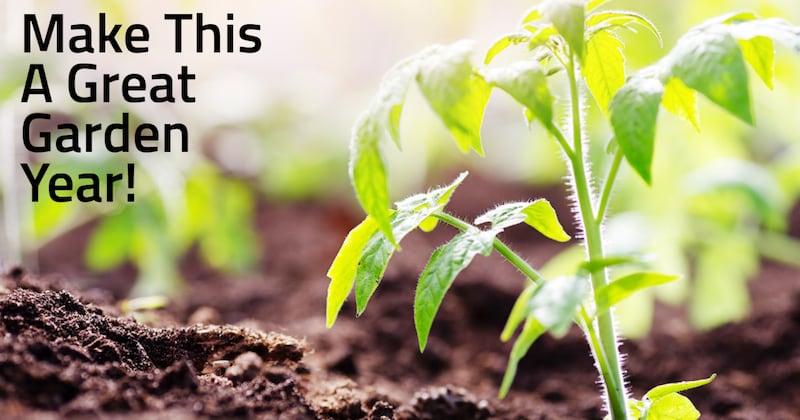
My eyes were drawn to the magazine perched on the rack. The new spring edition of Garden Gate magazine seemed to jump out at me with its title of “Great Gardens”. Plucking it from the display I thought, “Now that’s what I want this year, a totally successful and bountiful garden, a great garden!” If you are an experienced gardener you know that yearning, the inner aspiration to harvest the biggest, best and most beautiful veggies of all time!
If only there was a simple formula for gardening success. To be sure there are dozens and dozens of books on the shelves filled with page after page of gardening advice on things like insect and disease problems, soil and site considerations, varieties, and how to plant them, but a simple step-by-step approach to the great garden is very hard to find. What I hope to pass along to you here is a starter kit of information to get you going again, and with a good plan, your hard work, and God’s help, this could be the year for your greatest garden yet!
The good thing about gardening is that every year you get a ‘do-over’, another chance to get it right and reap the benefits. While we do get another chance at it every spring, don’t make the mistake of thinking that your garden plot is going to be a clean slate. The problems and issues that you have had in the past will reappear unless you take steps to modify the environment of the garden for the better. My best suggestion would be to start where you are and improve on what you have but don’t forget about what has happened in the past. This is one reason why keeping a garden log is so beneficial. You will know what kind of bug or disease attack occurred last year, when it happened and what seemed to work or not work as your treatment.
Speaking of disease and insects, it is so important that you rotate your vegetable types around so that they are placed in a new location every year. The bugs that feasted on the roots and the disease that ravaged the leaves are persistent in the soil over the winter and will attack their favorite host plants again if they are replanted in the same spot. So creating a large enough garden so you can rotate crops away from any spot for at least three years is very helpful.
If you haven’t gardened before, a big key to your future success will be the selection of the garden site. From past experience, I know that low-lying spots become swamps during rainy seasons and plants just drown or rot. You will have much more success when you put your garden in a high spot in the yard. If water stands everywhere when it rains then seriously consider making a raised-bed garden with 12 " high planks, concrete blocks, or stacking stones. The root zone of your tomatoes and everything else will be above the soaked ground and growth will continue even during long periods of abundant rain.
Gardens must be located in full sun, a little afternoon shade is ok, but really try to get 8 hours of sun for your garden every day. Because the vegetable garden is not the most ornamental thing to look at towards the end of the season, I suggest locating it out of view from the prominent picture windows of your house. It is also really advantageous to put the garden close to a water source, solid pathways, and a tool shed. This always saves me a lot of back and forth for hoses and hand tools.
If you are taking another crack at the garden then let’s just work on the existing environment. As I said above, simply start where you are and improve on what you have. Everything your vegetables need, except for oxygen and other atmospheric necessities, comes from the soil profile in your garden plot. it really pays off to work for better drainage and nutrition every year. I like to add up to 2″ of thoroughly composed manure and leaf compost before I spade my garden. It is remarkable what this one treatment does to improve things. The course materials really help to open up the soil even if you have tight clay. Microorganisms in the soil will break down the organic matter so the garden will have a rich supply of nutrients and minerals for the healthy growth of your plants. If you have done this before and still have marginal results, then take a sample of the soil to the county extension office near you and have it tested for nutrients and pH. You will get a sheet of recommendations back that will help you modify things so plants will grow healthy and strong.
I begin to plant my garden in early March. Root crops such as carrots, radishes, beets, and turnips can be sown at that time. Potatoes go in around mid-month and leafy vegetables like lettuce, chard, and spinach need to go in then as well. Don’t forget to plant your broccoli, cabbage, and cauliflower before the end of the month so they can grow up and produce heads before the real heat of summer arrives.
The warm season vegetables need to wait until after mid-April when the danger of frost has passed. Tomatoes can also go in around mid-April, with peppers and eggplants planted in late April. Corn, beans, and squash are best planted in early May, with okra and melons any time after that. The succession of crops will vary depending upon your experiences, but I encourage you to try different varieties that you get good reports on and consider ordering hardy heirloom seeds that you can save and re-sow from year to year. A good number of the early spring vegetables can be planted again in mid-August for a second chance fall garden. It’s an outstanding way to lengthen your harvest season. If you would like a copy of a super list of catalog companies, just check out the garden page at www.KRMG.com or email me at algardens@cox.net and I will be happy to send one along to you. Best regards and may you have a great garden this year!
Thanks for listening to the Gardening Show on 1023 KRMG Tulsa’s News and Talk!
Cox Media Group






